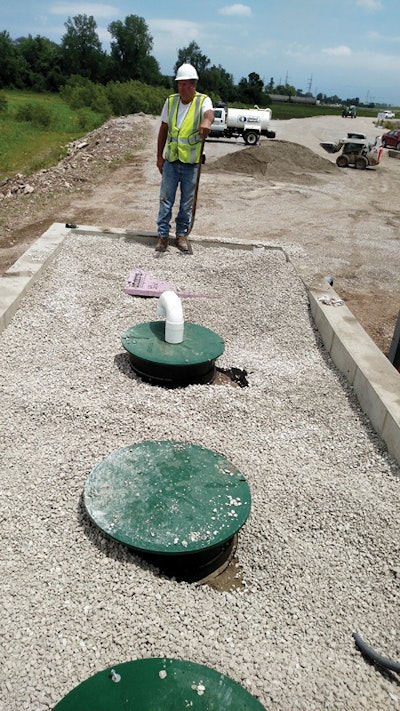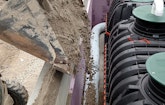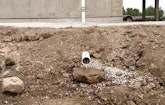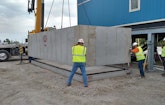
Interested in Systems/ATUs?
Get Systems/ATUs articles, news and videos right in your inbox! Sign up now.
Systems/ATUs + Get AlertsIn the commodity business, the Mississippi River is a place to be. This is where grain from Midwest farm fields is collected and loaded onto barges that haul harvests along the nation’s major rivers. Louis Dreyfus Co. wanted to be here. It planned a large grain storage and shipping depot in Cahokia, Illinois, on the bank of the Mississippi and opposite St. Louis. But there was a problem with the site: The river’s floodplain included the entire parcel of chosen land.
Compounding this was a recent rule change in Illinois that forbids the long-term use of holding tanks. They may still be used, but for no more than 12 months. The company did not want long-term use of portable restrooms, but prospects looked poor for a permanent wastewater solution.
“From a waste standpoint it was straightforward,” says Ray Tebo of New Excavating Technology in St. Anne, Illinois.
The only building on the site at the time was an office structure about 70 feet long and 18 feet wide. It is filled with computer stations for the company’s workers, but it is also elevated 8 feet above grade on stilts. There are two reasons for this. One, if the site floods the building will be above it. Second, the workers inside can look down on the truck scales and loads of grain coming onto the property. Two restrooms and a small kitchen are the only wastewater sources.
No soil and high water
The job started when Tebo received a call from an engineer for Dreyfus. Although it was 250 miles away, far from his normal radius of operations, Tebo agreed to look at the project.
“The site had nothing but 30 or 40 feet of fill, and it was like that over all 27 acres,” he says.
The engineer explained the plan for the building and said a standard septic system wouldn’t work. Plans called for the finished site elevation to be 6 inches above the floodplain. That elevation is also the 100-year flood mark. Building up the grade by several feet to allow for proper separation between a drainfield and the water table would have involved a large cost the company didn’t want to pay, and the company wanted to keep the entire property covered with gravel to provide maximum maneuvering room for trucks.
Tebo proposed a membrane bioreactor because its very clean discharged water would pose no environmental hazard. Permit limits for the project are: BOD of 45 mg/L, TSS of 45 mg/L, and 400 cfu/100 mL on fecal coliform.
Out in plain sight
Wastewater leaves the office building in a 4-inch Schedule 40 PVC pipe that drops a few feet before entering a 10- by 25-foot concrete vault that holds the wastewater system.
First in line is a trash tank, an Infiltrator Water Systems IM540 540-gallon plastic tank with a 1/8-inch slotted Bio-Microbics SaniTEE effluent screen on the outflow to intercept debris. Next, the water flows into a 1,530-gallon Infiltrator IM1530 tank that holds the BioBarrier MBR. A pump supplied by Bio-Microbics, and switched on and off by a float, pulls water through at a rate of 1/2 gpm. A Bio-Microbics panel controls the system.
The vault was an installation job in its own right. Workers putting up the office building added in compacted gravel to the grade Tebo specified. The vault’s walls are about 10 inches thick and the floor is about 12 inches thick. It was made by Wieser Concrete, and came in two pieces — base and walls — on two trucks. A crane put the 126,000-pound vault together.
Against the inside walls of the vault are 2-inch hard insulation panels designed for underground use. Around the bottom is 4-inch drain tile wrapped in 10-inch drainage EZflow to collect water running down inside the vault.
The inside of the vault is filled with about 5 feet of sand to insulate components from cold weather. On top of the sand is landscape fabric to prevent weeds from taking root, and on top of the fabric is 1 foot of clean 1-inch stone.
Tebo offered to disguise the vault with a roof or shed, but the owners were happy with having the vault exposed.
The 4-inch discharge pipe from the MBR goes through the wall of the vault, turns 90 degrees, and falls about 4 feet to join the 4-inch pipe from the interior-perimeter drain. About 40 feet from the vault the pipe discharges water onto the surface of the ground.
In the middle of that 4-foot drop technicians installed a breakaway section. This serves two purposes. First, it allows technicians to sample discharge water from the MBR. Second, in the event the site does flood, that section of pipe can be removed to prevent floodwater from backing up into the MBR.
Good planning means quick work
“It took a long time to get all the permits,” Tebo says. In addition to an NPDES permit for surface water discharge, the local health district had to give approval, but had never overseen such an installation. The Illinois state Health Department had to give permission, as did the U.S. Army Corps of Engineers.
But the project itself went smoothly.
“It was crazy how well it went together, but we planned for this for about a year,” Tebo says.
He and his technicians knew the dimensions of the concrete vault, so inside their MBR shop they build a mock-up of the design using a plywood box built to the interior dimensions of the concrete vault. When they drove to Cahokia, they hitched an 18-foot double-axle aluminum trailer to Tebo’s 1/2-ton Dodge Ram EcoDiesel pickup and on that put the two plastic Infiltrator tanks. Another Dodge Ram carried the technicians, tools, and smaller components.
Workers building the Dreyfus facility had a Bobcat skid-steer on site, and they let Tebo’s technicians use it for a small bit of finish grading on the vault pad and for filling the inside of the vault with sand and stone.
“We drove down one morning loaded, and we were on the road home at 1 p.m. the next afternoon. On the night in between we went to a Cardinals game in St. Louis,” Tebo says.
The first day was for setting the vault and installing the tanks. Next morning the crew installed the electronics and started up the system. Technicians from New Excavating Technology still return quarterly to check the parameters and operation of the system.
Louis Dreyfus still has to ship in freshwater to run its bathroom because the local health department does not allow well drilling in the Mississippi River floodplain. The company put in a holding tank that is filled periodically. But with modern wastewater technology the company can do business where it needs to, and it can do that business without harming the river its business depends on.









